ThermalTake Tenor (cont’d)
Getting away from the front, we find that the Tenor keeps a relatively simple look for the rest of the case. Extra ventilation is situated over the CPU and video card, which certainly seems to make sense.
A head-on shot of the back reveals the major difference of the Tenor in plain view; the power supply is not in the front of the case at all as it was in the other HTPC cases that we’ve looked at so far.
Before diving inside the Tenor, here is one of the feet of the case. Just like most HTPCs, with nice looking feet, the case should fit much better when placed with other pieces of equipment.
Taking off the three-side cover reveals a complicated bracing and drive cage layout, but without the side panels and after the removal of the braces, this actually becomes a very easy case in which to work.
The entire front of the case comes away as well, and in this angle shot here, we can get a better idea of how this case is constructed. One nice aspect that we noticed at this step is that all the cables from the front go through one hole, which has been rounded out carefully.
Taking the two braces away and focusing on the front, we find the three 5¼” drive bays and triple 3½” bay (two of which are externally accessible). To actively bring in cooler air, one 80mm fan is located here as well, but we couldn’t help but notice that there aren’t enough ventilation holes to cover the area of the fan’s blades.
And here, we can finally see just how open the Tenor can get. Looking at the back, it actually looks much more like a typical ATX case, just turned on its side, with two 70mm Thermaltake fans taking care of exhausting the majority of the warm air from the case.
Getting away from the front, we find that the Tenor keeps a relatively simple look for the rest of the case. Extra ventilation is situated over the CPU and video card, which certainly seems to make sense.
A head-on shot of the back reveals the major difference of the Tenor in plain view; the power supply is not in the front of the case at all as it was in the other HTPC cases that we’ve looked at so far.
Before diving inside the Tenor, here is one of the feet of the case. Just like most HTPCs, with nice looking feet, the case should fit much better when placed with other pieces of equipment.
Taking off the three-side cover reveals a complicated bracing and drive cage layout, but without the side panels and after the removal of the braces, this actually becomes a very easy case in which to work.
The entire front of the case comes away as well, and in this angle shot here, we can get a better idea of how this case is constructed. One nice aspect that we noticed at this step is that all the cables from the front go through one hole, which has been rounded out carefully.
Taking the two braces away and focusing on the front, we find the three 5¼” drive bays and triple 3½” bay (two of which are externally accessible). To actively bring in cooler air, one 80mm fan is located here as well, but we couldn’t help but notice that there aren’t enough ventilation holes to cover the area of the fan’s blades.
And here, we can finally see just how open the Tenor can get. Looking at the back, it actually looks much more like a typical ATX case, just turned on its side, with two 70mm Thermaltake fans taking care of exhausting the majority of the warm air from the case.


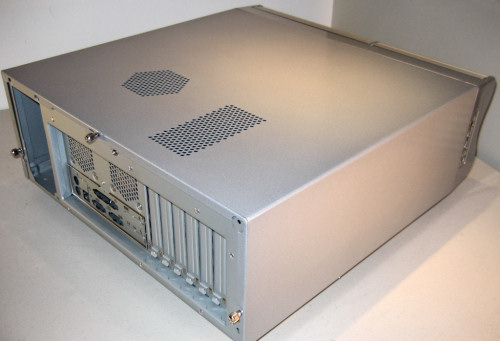
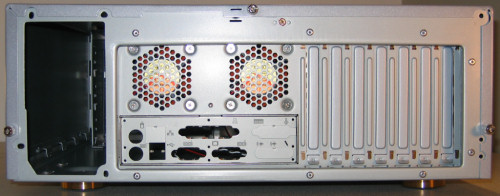
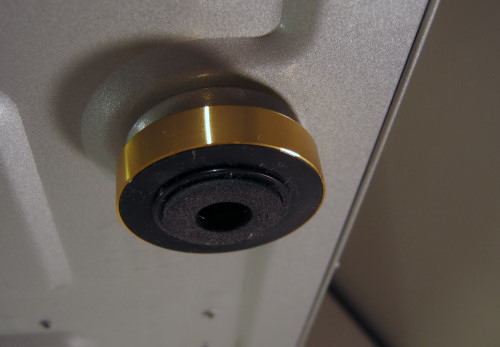
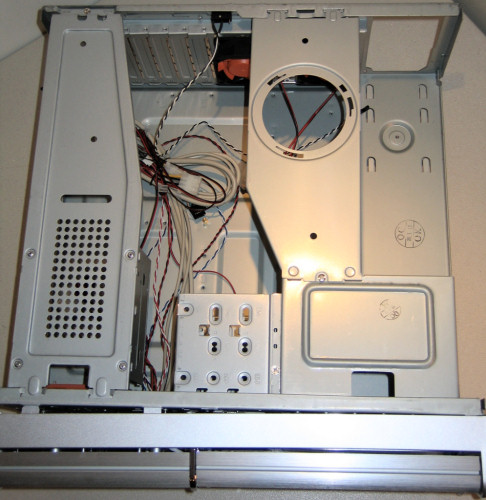
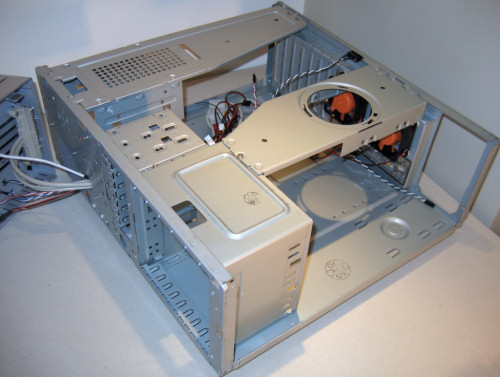
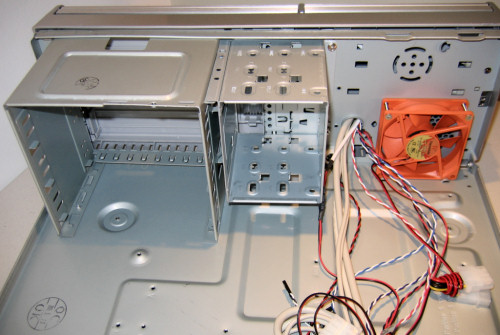
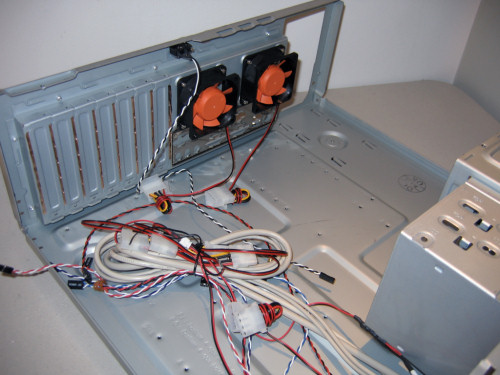








26 Comments
View All Comments
BigandSlimey - Tuesday, November 22, 2005 - link
These guys http://www.atechfabrication.com/products/HTPC_case...">http://www.atechfabrication.com/products/HTPC_case... have been designing their cases in conjunction with the HTPC guru's at avsforum. I'd suggest anyone planning to build a HTPC to go to http://www.avsforum.com/avs-vb/forumdisplay.php?f=...">http://www.avsforum.com/avs-vb/forumdisplay.php?f=... and do some reading, there's a lot to consider.I'm also surprised at your omission of the Ahanix cases http://www.ahanix.com/ahanix_product_list.asp?cid=...">http://www.ahanix.com/ahanix_product_list.asp?cid=... which IMO look a lot better than any of the options on your article.
See also: http://www.origenae.com/products_htpc.htm">http://www.origenae.com/products_htpc.htm
http://www.silverstonetek.com/product-case.htm">http://www.silverstonetek.com/product-case.htm
ceefka - Tuesday, November 22, 2005 - link
Those Origenae look very nice. I meant the X15 in my earlier comment. This one will cost around 500 bucks. Expensive, but very pretty.lukecon - Tuesday, November 22, 2005 - link
All well and good on the review love AnandTech's review but I think you guys forgot something - The TV tuner in your system - I mean it is a Home Theater PC.Tamale - Tuesday, November 22, 2005 - link
The tuner shouldn't really pose any additional problems with a particular case, and the 6600GT we use gets as hot or even hotter than most video cards with built-in tuners.Perhaps the cooling in an HTPC would be changed dramatically though if another expansion card is also in the system.. hmm.. I'll have to think about that one. Thanks for the comment.
BigLan - Tuesday, November 22, 2005 - link
Actually, tuners can get pretty toasty, maybe not as hot as a video card, but they don't have active cooling on them. An MCE-500 dual tuner stuck in the last slot with no airflow could be a problem.If you are adding a soundcard as well, it can also impede airflow which exacerbates the problem.
tkr2099 - Tuesday, November 22, 2005 - link
Very nice review! I'm planning on building a HTPC this holiday season, so this review could not have come at a better time. Thank you, Anandtech, for another extremely well written and helpful review!tayhimself - Tuesday, November 22, 2005 - link
IMO Silverstone especially and less so Ahanix are specialized HTPC vendors. Either you didnt know this, didnt bother to do research, or didnt get a free sample from them. None of which is a terribly good thing.AFAIK no 3R systems cases have been available in North America since about 3 years ago when newegg carried a few. Theyre a Korean manufacturer of quality cases that are quite popular in Australia (I'm in Canada FYI).
Also, why the POS power supply along with the lousy thermaltake heatsink with a hot P4 system? Not too many people are building HTPCs with P4s, and they tend to use better components than Mad Dog and ThermalTake (no offense to the *bling* obsessed).
The measurements dont jive with the subjective measurements as a 9 dB difference between the loudest and quietest is almost twice as loud.
A poor review, that doesnt belong on AT. I could probably write a better review and I've never done one before.
MPE - Tuesday, November 22, 2005 - link
I could probably write a better review and I've never done one before.Cop out - not to mention inconsequential, immature, ad hominem, and probably false.
tayhimself - Tuesday, November 22, 2005 - link
ad hominem? Go to http://dictionary.com">dictionary.comceefka - Tuesday, November 22, 2005 - link
Isn't that just perfect? If you can get these temperature numbers with P4, you know that a 90nm s939 is going to do just fine.There are so many cases to chose from. Even with built in LCD screens (not cheap btw). Maybe AT can inlcude HTPC's in their entry/mid-range/high-end reviews and builds. On the other hand, this could be a totally different category by itself. You'd also have the opportunity to chose platform.
This brings forth the next question: How long before Apple makes a Home-Pod, HTPC based on Mac ingrediënts. They should be able to make/develop one by now.